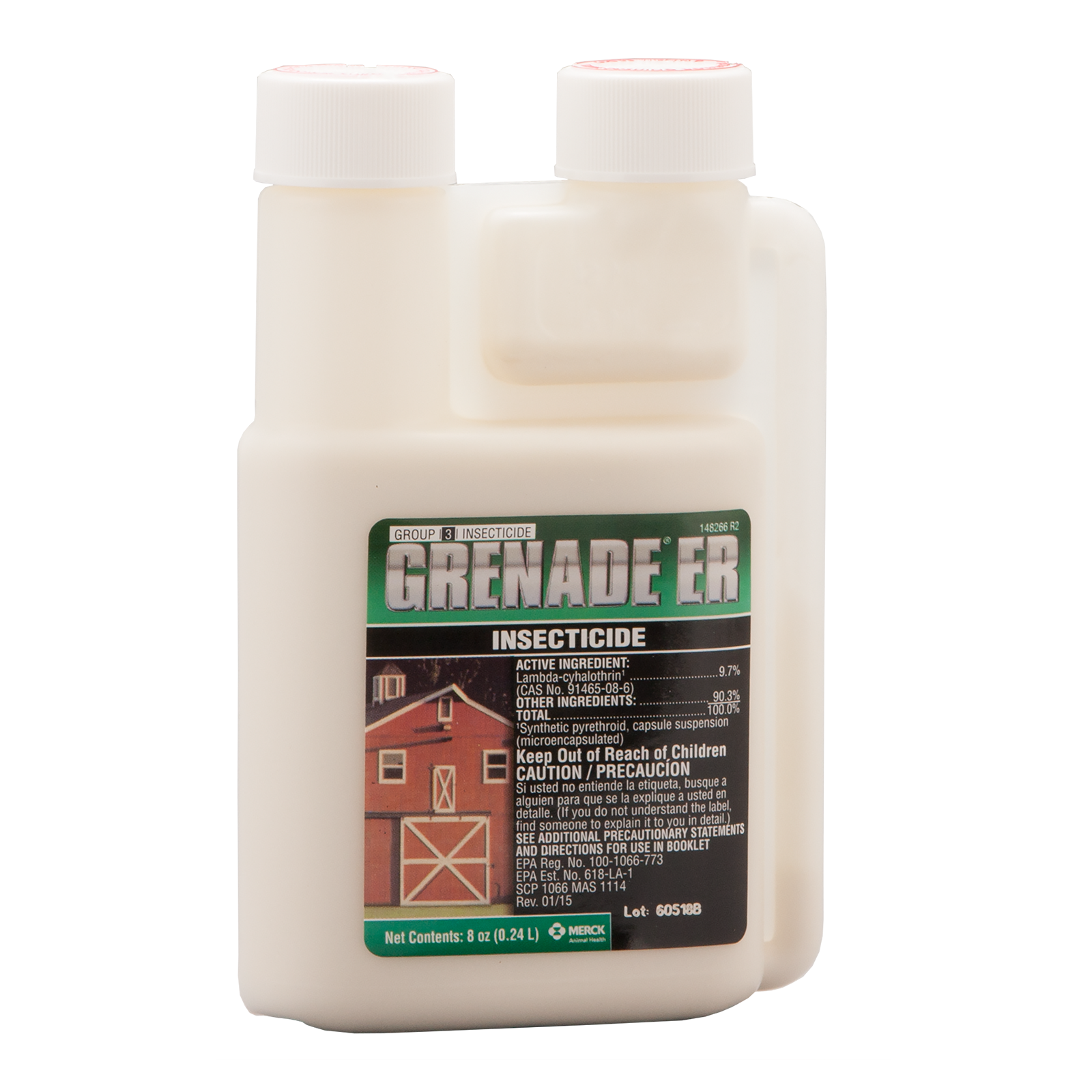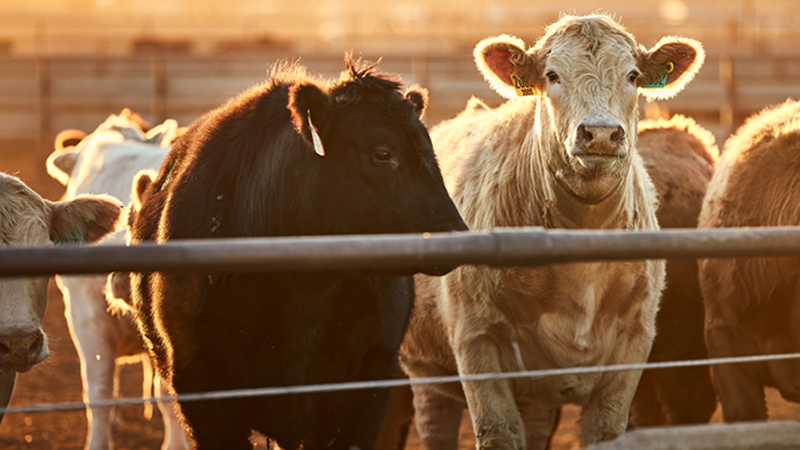GRENADE® ER
GROUP | 3 | INSECTICIDE
Product Description
9.7% lambdacyhalothrin. A broad-spectrum premise insecticide for pest control in, on and around livestock buildings, structures and surroundings. Microencapuslated for long-lasting control of a wide variety of insects that plague surfaces.
Control crawling and flying insects around animal facilities with Grenade ER. It contains the most powerful insecticide available in a premise spray.1


Indications
For use in, on and around buildings and structures for the control of listed pests, including on lawns, ornamental trees and shrubs around residential, institutional, public, commercial, agricultural and industrial buildings; and parks, recreational areas and athletic fields. Do not use on golf course turf.
Features And Benefits
- Provides three months of premise protection1
- Microencapsulation delays breakdown of active ingredient1
- Effective on difficult-to-treat surfaces (vinyl, cement, other porous materials)1
- Contains lambdacyhalothrin, the most powerful insecticide available in a premise spray1
- Twice the bioactivity of other common insecticides1
Recommended
Grenade® ER Insecticide is a Group 3 Insecticide that contains the active ingredient lambda-cyhalothrin. Due to the inherent risk of the development of resistance to any pesticide product, it is strongly advised that Grenade® ER Insecticide be used in a sound resistance-management program. It is recommended that the following resistance management practices be followed, including, but not limited to:
- Rotating Grenade® ER Insecticide with products with different modes of action,
- Avoiding treatment of successive generations with Grenade® ER Insecticide , and
- Using labeled rates at specified spray intervals.
Active Ingredients
9.7% Lambda-cyhalothrin2
Supplied
EIGHT-8 fluid oz (0.24 L) plastic containers
Safety
KEEP OUT OF REACH OF CHILDREN. HAZARDS TO HUMANS AND DOMESTIC ANIMALS. READ ALL SAFETY PRECAUTIONS AND MATERIALS.
Harmful if absorbed through skin. Avoid breathing spray mist or vapor. Avoid contact with skin, eyes, or clothing. Wash thoroughly with soap and water after handling, and before eating, drinking, chewing gum, using tobacco, or using the toilet. Remove contaminated clothing and wash before reuse. Prolonged or frequently repeated skin contact may cause allergic skin reactions in some individuals.
Environmental Hazards: This product is extremely toxic to fish and aquatic invertebrates. To protect the environment, do not allow pesticide to enter or runoff into storm drains, drainage ditches, gutters, or surface waters. Applying this product in calm weather when rain is not predicted for the next 24 hours will help to ensure that wind or rain does not blow or wash pesticide off the treatment area. Rinsing application equipment over the treated area will help avoid runoff to water bodies or drainage systems. Drift and runoff from treated areas may be hazardous to aquatic organisms in neighboring areas. Apply this product only as specified on the label. When making applications, care should be used to avoid household pets, particularly fish and reptile pets.
This product is highly toxic to bees exposed to direct treatment or residues on blooming crops or weeds. Do not apply this product or allow it to drift to blooming crops or weeds if bees are visiting the treatment area.
Physical and Chemical Hazards: Do not use this product in or on electrical equipment due to the possibility of shock hazard.
Important
Not for use on plants being grown for sale or other commercial use, or for commercial seed production, or for research purposes. For use on plants intended for aesthetic purposes or climatic modification and being grown in interior plantscapes, ornamental gardens or parks, or on lawns or grounds.
- Do not apply directly to impervious horizontal surfaces such as sidewalks, driveways, and patios except as a spot or crack-and-crevice treatment. During application, do not allow pesticide to enter or runoff into storm drains, drainage ditches, gutters or surface waters.
- All outdoor applications must be limited to spot or crack-and-crevice treatments only, except for the following permitted uses:
- Treatment to soil or vegetation around structures;
- Applications to lawns, turf, and other vegetation;
- Applications to building foundations, up to a maximum height of 3 feet above grade;
- Applications to underside of eaves, soffits, doors, or windows permanently protected from rainfall by a covering, overhang, awning, or other structure;
- Applications around potential pest entry points into building, when limited to a surface band not to exceed one inch in width;
- Applications made through the use of a coarse, low-pressure spray to only those portions of surfaces that are directly above bare soil, lawn, turf, mulch or other vegetation, as listed on the label, and not over an impervious surface, drainage or other condition that could result in runoff into storm drains, drainage ditches, gutters, or surface waters, in order to control occasional invaders or aggregating pests.
- Do not water the treated area to the point of runoff.
- Do not make applications during rain.
- Do not apply directly to sewers or drains, or to any area like a gutter where drainage to sewers, storm drains, water bodies, or aquatic habitat can occur, except as directed by the label.
This product is restricted for use in the State of New York.
Resistance Management
Grenade® ER Insecticide is a Group 3 Insecticide that contains the active ingredient lambda-cyhalothrin. Due to the inherent risk of the development of resistance to any pesticide product, it is strongly advised that Grenade® ER Insecticide be used in a sound resistance-management program.
It is recommended that the following resistance management practices be followed, including, but not limited to:
- Rotating Grenade® ER Insecticide with products with different modes of action,
- Avoiding treatment of successive generations with Grenade® ER Insecticide , and
- Using labeled rates at specified spray intervals.
For additional information about implementing these or other resistance management practices, consult a company representative.
Storage And Disposal
Do not contaminate water, food, or feed by storage and disposal.
Pesticide Storage: Keep container closed when not in use. Do not store near food or feed. Shake well before use. Protect from freezing. In case of spill or leak on floor or paved surfaces, soak up with sand, earth, or synthetic absorbent. Remove to chemical waste storage area until proper disposal can be made.
Pesticide Disposal: Pesticide wastes are toxic. Improper disposal of excess pesticide, spray mixture, or rinsate is a violation of Federal law. If these wastes cannot be disposed of by use according to label instructions, contact your State Pesticide or Environmental Control Agency, or the Hazardous Waste representative of the nearest EPA Regional Office for guidance.
Container Handling: Nonrefillable container. Do not reuse or refill this container. Triple rinse container (or equivalent) promptly after emptying. Triple rinse as follows: Empty the remaining contents into application equipment or mix tank and drain for 10 seconds after the flow begins to drip. Fill the container 1/4 full with water and recap. Shake for 10 seconds. Pour rinsate into application equipment or mix tank or store rinsate for later use and disposal. Drain for 10 seconds after the flow begins to drip. Repeat this procedure two more times. Then offer for recycling if available or puncture and dispose of empty container in a sanitary landfill or by incineration.
Contact
U.S. only: Merck Animal Health, contact us or call 1-800-211-3573
For more information regarding efficacy and safety data, go to productdata.aphis.usda.gov
For additional information, please see the product label.
References
- Competitive Comparison: DEMAND Versus CYONARA 9.7, http://www.syngenta-us.com/images/resource_pages/pmp/demand_ez_ss_compare.pdf, Syngenta Crop Production Inc., 2008.
- Synthetic pyrethroid, capsule suspension (microencapsulated)

An effective deworming program can help you make the most of your vaccination protocol.

See the simple, three-pronged approach that can help mitigate the damaging effects of pinkeye.
